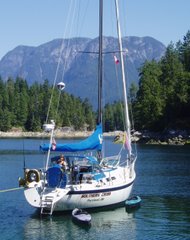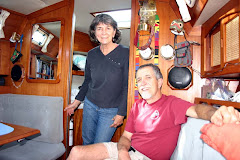
(thanks to David Simone for this professional-quality photo)
Sitting here in the marina in Santa Rosalía for the past few days, we have been busily preparing our boat to be hauled out for hurricane season. We've cleaned and repaired things we won't be using until next fall, and separated out things we want to take home, and things we don't want to keep. Some we'll give to locals, some we'll try to sell to other cruisers (and then give to locals if we don't sell them).
LOOKING BACK
We've also had time to reflect on the past 9 months of cruising. What a great ride it's been! The biggest success is being able to live together 24/7 in such a small space. That would be a non-starter for many! While we don't always get along, we have done great overall.
Southern Cross has also done well, with very few breakages or failures. It has been a comfortable home, and fun to sail. We often see other boats that we think we would like better, but every boat has its trade-offs. For us, the biggest consideration is the high cost of changing boats, in terms of selling this one, seeking a new one, outfitting it, and learning how to operate and maintain it properly. Unless we decide to cruise full-time (or someone offers us a lot of money), we will probably keep this boat for the foreseeable future.
Although the destination was Mexico, we enjoyed the voyage down the OR and CA coasts just as much, and sometimes more. We are very glad we got to explore so many places along the way, and wish it wasn't so hard to get the boat back to Oregon, because we would love to start over and visit them all again.
Mexico has been a much, much better destination than we had thought. We never believed any of the sensational negative press in the US (my mother keeps asking if we have seen any pirates), because we have traveled here before. Still, we have been blown away by the generosity and warmth of the Mexican people. Talk about "family values": in Mexico people spend most of their time and energy on the other people in their lives, not on accumulating an endless string of possessions. And gringos are welcomed into the fold to whatever degree you want to participate. You don't need to speak fluent Spanish; most Mexicans are delighted by any effort you make.
Several things have improved here dramatically in the past few years: hygiene, telecommunications, and availability of consumer goods. Neither of us has been sick this year (knock wood); we can easily get email, manage finances, and telephone loved ones; and there are very few things that we can't find in stores down here.
We have made a lot of new friends among the cruising community. We have met people who are very different from us, who we probably never would have met on land. We have learned a lot from them, and we have enjoyed sharing experiences in the water and on the shore. We have tried to help others when we can, and we have received a lot of help ourselves. As with many activities, there is a strong sense of community among cruisers.
LOOKING FORWARD
We are very much looking forward to seeing friends, family, and home. We both feel that, so far at least, we don't want to be full-time cruisers. We still have too many roots connecting us to Oregon.
We want to resume sailing life sometime next fall. Since we are leaving the boat in Mexico, we will be spending at least part of next season here. There is plenty more to see, and many cruisers never get beyond Mexico. We have discussed at length the advantages of retiring here, including excellent and inexpensive medical care. But (most of the time) we think we want to move on and explore other places. After all, that's what drew us to sailing in the first place: seeing new places, having new experiences. And unlike many cruisers, we are already familiar with Mexico from earlier travels here.
The more difficult decision is where to go. For my part, I have always been most drawn to the South Pacific, and to a lesser extent, Southeast Asia. We met many cruisers this past year who have already crossed to the Marquesas. But we both have questions about that route: is the boat good enough? Are we good enough? Will we enjoy being on the boat for long passages? How much will it cost? How long will we be gone? How will we get the boat back? In many ways, a Pacific crossing requires much more preparation and commitment than the coastal cruising we have done so far.
Vicki is more interested in going through the Panama Canal and entering the Caribbean. We know, from dive trips, sea kayak voyages, and sailing trips on our friends' boat, that the snorkeling and diving is better than here, and tradewinds make for more reliable sailing. Also, there are places to leave the boat, and we can return home almost as cheaply as from Mexico. But the Caribbean is way more crowded, and way more expensive. Plus, we have been there a lot, so it will not seem like a new experience. But we do like the idea of eventually heading up the eastern coast of the US and Canada, which would be mostly new to us.
So we still don't really know where we'll go from here. But we do hope to continue the voyage!
Now is all the time we own
For no one has the power
To know when their clock of life will stop
At late or early hour
The future is just a dream of hope
The past a distant link
Go cruising now, my brother
It's later than you think
(found at the San Juanico "Cruiser's Shrine")
















